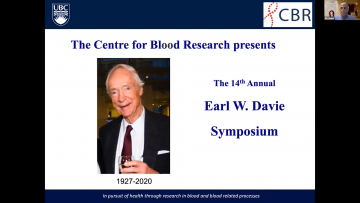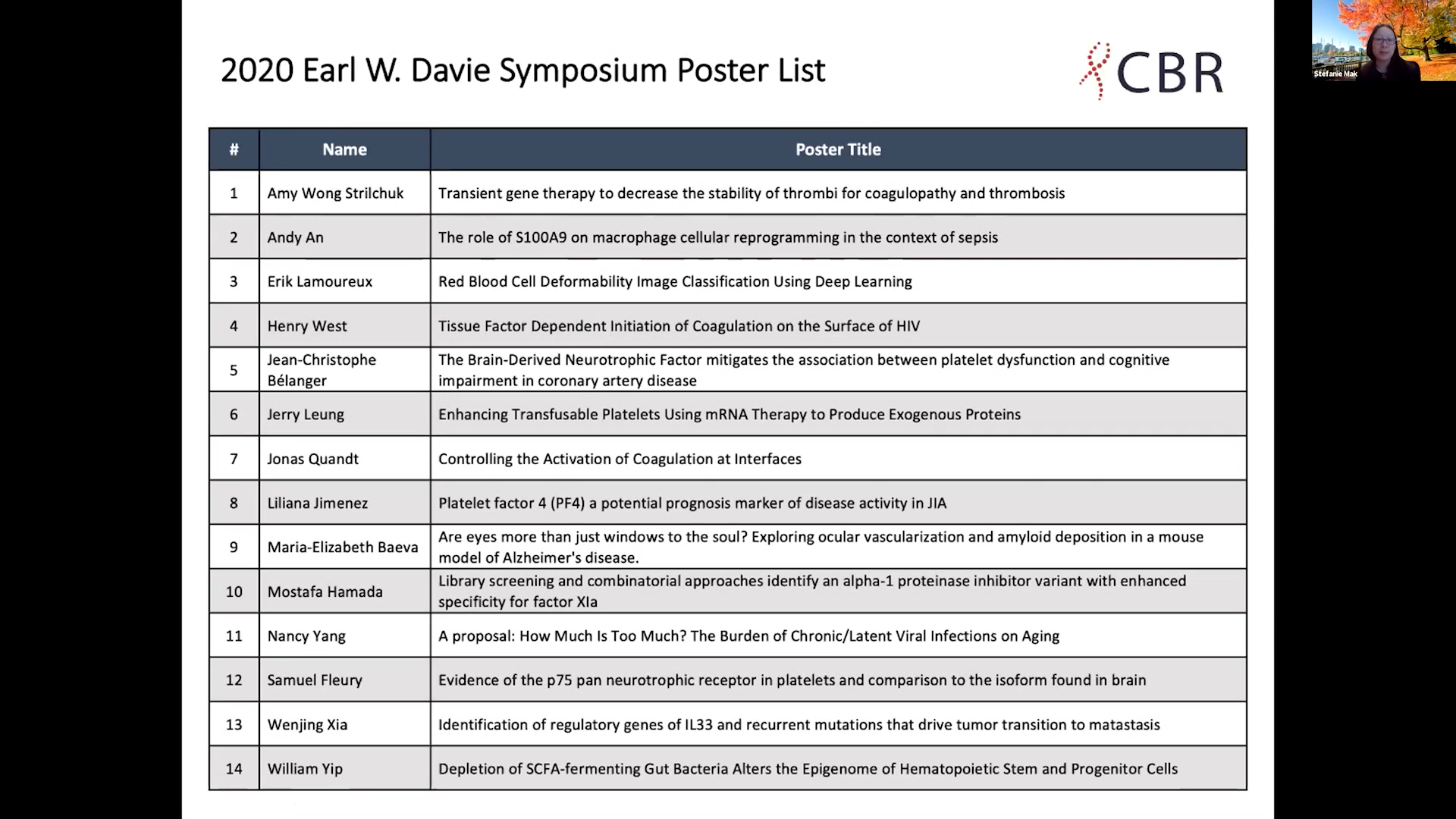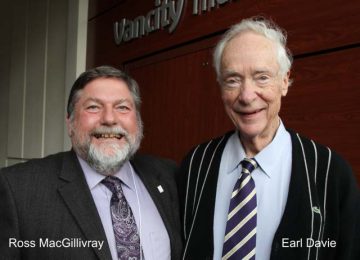
In the opening remarks of the 14th Earl W. Davie Symposium, CBR Director Dr. Ed Conway offers a virtual welcome to all the symposium attendees
With the advent of November comes a much-anticipated event for the Centre for Blood Research (CBR) community: the Earl W. Davie Symposium. This annual, one-day conference features expert presentations on bleeding, thrombosis and coagulation research. Hosted in honour of Dr. Earl Davie, the 2020 symposium was held virtually to great success. Over 300 registrants from a mix of local, national and international audiences gathered online on November 17th to honour Earl’s legacy and participate in an excellent program with presentations by leading experts, trainees and patients.
Now in its fourteenth year running, this Earl W. Davie Symposium would mark the first one without Earl since his passing in June. In the event’s opening remarks, CBR Director Dr. Ed Conway took a moment to describe some of Earl’s many accomplishments and his ongoing legacy in the research and CBR communities. As an eminent biochemist, Earl is best known for his discovery of the Waterfall Sequence of Blood Clotting, which described the “cascading” effect of factors involved in blood coagulation. As a mentor and close friend to the CBR, Earl was well-known for his mentorship, endless curiosity and kindness to all those around him, from early-career trainees to long-time lab colleagues.
Following these opening remarks, the symposium began with a presentation by Dr. Jeffrey Weitz, a professor at McMaster University and the recipient of the Naiman-Vickars Professorship. Building on the topic of coagulation, Dr. Weitz’s talk explored how Factor XI, one of the many enzymes that influences blood clotting, could be used as a target for new anticoagulant drugs. The symposium also hosted two keynote speakers, Dr. Mary Cushman of the University of Vermont and Dr. Thomas Ortel of Duke University, who spoke about racial disparities in stroke and antithrombotic therapy in COVID-19, respectively, two critical and timely topics. Dr. Cushman described how stroke is the leading cause of disability and the fifth leading cause of death in the United States, sharing insights into why stroke-related death is twice as common in the Black population, while Dr. Ortel’s presentation shed light on antithrombotic therapies for those suffering from COVID-19.

Dr. Stefanie Mak, the CBR’s Education Program Manager, gives instructions for the virtual trainee poster presentation sessions that took place through breakout rooms
After the morning presentations, 14 trainees from both Canadian and international institutions had the opportunities to present their research through virtual poster sessions. Facilitated by breakout sessions, attendees and poster judges could freely listen to, discuss and engage with different presenters in an online format. The trainee talks covered a wide variety of topics, from improving platelets for transfusion, to the effect of viral infections on aging, to using deep learning to classify red blood cell deformability. Jean-Christophe Bélanger of the Montréal Heart Institute won the first-place award for best poster, while Nancy Yang of the Côté Lab and Andy An of the Hancock Lab — both from the CBR — tied for the runner-up award.
The first half of the afternoon followed with a pairing of patient and research talks, which centred around two health conditions involving critically low numbers of platelets: heparin-induced thrombocytopenia (HIT) and immune thrombocytopenia purpura (ITP). Dr. Benjamin Lai of UBC first discussed challenges in treating HIT, a presentation that was followed by Dr. Judith Hall’s description of her experience with HIT and patient care. Chrystal Gellein, another patient, then shared her ITP story, from the diagnosis in her late teens to her journey of adapting to everyday life with her condition. This was followed by a presentation by Dr. Donald Arnold, director of the McMaster Centre for Transfusion Research, on recent advances in ITP research. The integration of patient experiences with research perspectives provided a thoughtful avenue for discussing future directions in treating these diseases and improving patient care, and served as a reminder that behind all scientific research are the people whose lives are affected by such work.

A photo of Dr. Earl Davie with CBR founding director Dr. Ross MacGillivray
After a packed day of insightful presentations, the symposium’s closing notes included a tribute to Earl by both Drs. Conway and Ross MacGillivray. It was Dr. MacGillivray, the CBR’s founding Director and Earl’s former student, who first established the symposium in 2007. During the closing notes, in a video clip shown from the 2013 event, Dr. MacGillivray shared the spirit of Earl’s teachings and philosophies: “Earl is a very special person who taught us not only to do good science, but to enjoy it, and that nice people can actually come first.” The symposium concluded with a remark from Dr. Conway, who invited all attendees to participate in the 15th Earl Davie Symposium next year, where Earl’s legacy in research and excellence will continue.
The impact and success of the 2020 Earl Davie Symposium would not have been possible without the sponsors of the symposium: the Naiman-Vickars Endowment Fund, Novo Nordisk, Pfizer, Bayer, the Canadian Blood Services, Biorender, Alexion Pharmaceuticals, and Grifols.
- Watch a video recording of the 2020 Earl W. Davie Symposium here
- Learn more about Dr. Davie’s seminal work in the 2017 R.E.D. blog: “Earl W. Davie Symposium – Eleven years and counting”.
- Read the Centre for Blood Research’s tribute to Dr. Davie here.
- Learn more about Dr. Davie’s career in this obituary from the Journal of Thrombosis and Haemostasis by Drs. Ross MacGillivray and Edward M. Conway.


